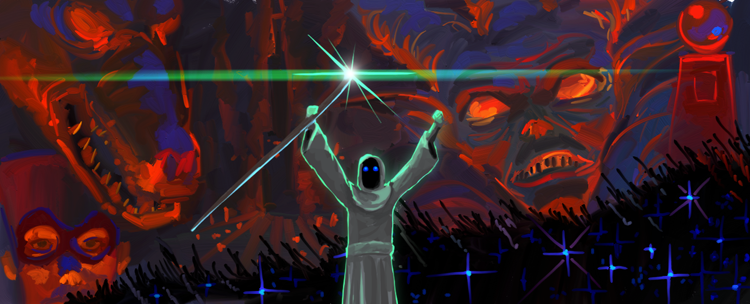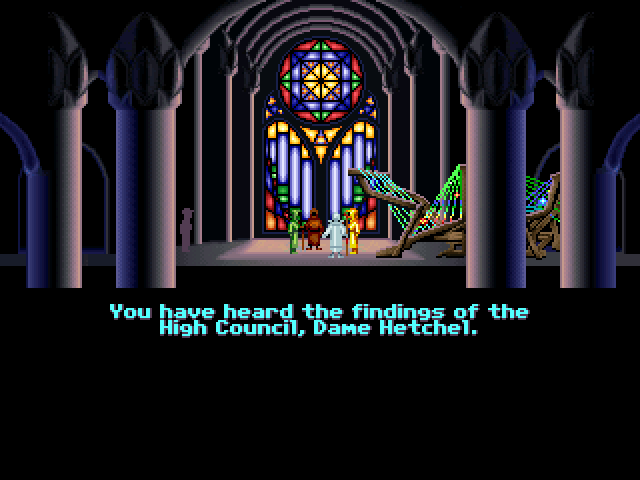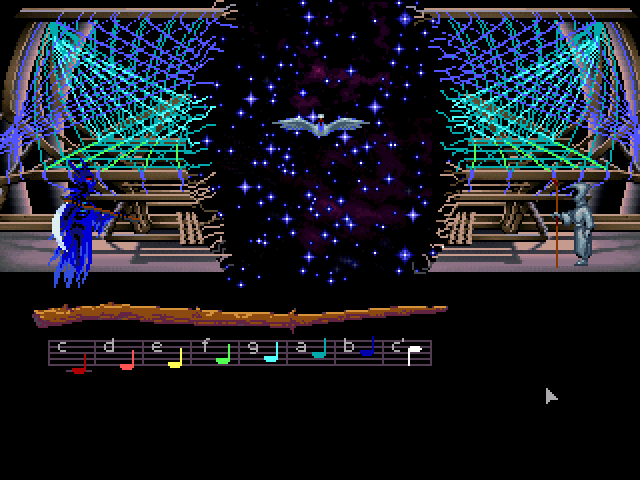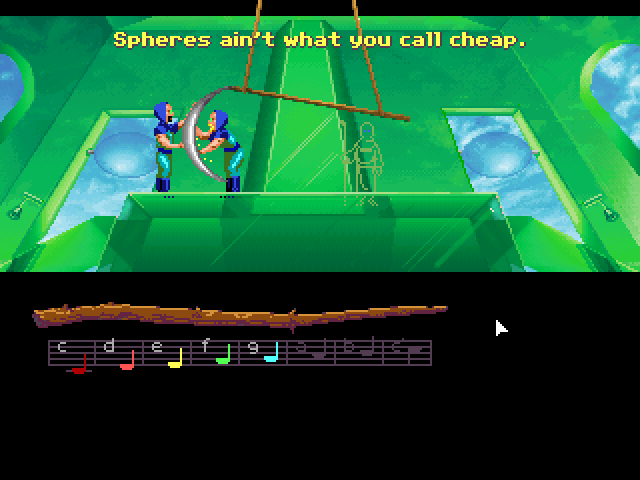Articles

LucasArts' Secret History #4: Loom Our Review
This month in "LucasArts' Secret History" we look at Loom, a game that you probably might not know much about. Thanks once again to Dan "Jayel" Lee for the Loom header image.
By the time Indiana Jones and the Last Crusade was put into production, LucasFilm Games had gotten their versatile SCUMM engine to a place where it was possible for multiple and highly different projects to be developed on the acclaimed story system simultaneously. Such was the case with Indy3 and Loom, two titles released within a year of each other and with which a shared engine is just about the only similarity.

The astoundingly unique Loom was the brainchild of Brian Moriarty, a fantasy storyteller from the olden days at the legendary Massachusetts based Infocom, home to the classics Zork and Hitchhiker's Guide to the Galaxy. There he designed such well-regarded text adventures as Wishbringer and the epic fantasy Trinity. With Loom, Moriarty made his foray into graphic adventures, and his latest company of employment attempted its first tonally serious entry in a genre where wackier point 'n click tales were considered their claim to fame. Reflective of its project leader's seasoned background with worlds realized through words only, Loom stands out in the LucasArts adventure canon as particularly literary and richly envisioned, and for more than these reasons is one of the most special and engaging experiences one is likely to find in a computer game.
The story of Loom takes place in a... period (we're given an 81st century year, talk of being in the wake of the "Second Shadow," and the presence of things like dragons, wizards, and crystal balls) called the Age of the Great Guilds, so named because all humans are organized into close-knit communities by a shared trade, called, well, Guilds. Among these city-states are the professional societies of the Blacksmiths, the Shepherds,the Glassmakers, and the Clerics. The game's protagonists belongs to the enigmatic Guild of Weavers, an isolated and obscure lot despite being the most powerful of the societies.
Cloaked in meticulous robes, their faces shrouded in darkness except for their emotive eyes, the reclusive Weavers are a secretive brotherhood of limited ranks who live on a small island dubbed "Loom." The island's namesake is a giant, magical, weaving apparatus in the village Sanctuary that the Guild reveres as sacred and which is guarded and "interpreted" by the three Elders. Over the years of their history, the Weavers graduated from the humble craft of weaving cloth to weaving "subtle patterns of influence into the very fabric of reality." Weavers use their wooden distaffs to spin these spells or "drafts" out of four musical notes or "threads." The emanating Loom functions as a sort a pulse for the fragile fabric of the universe itself - the Pattern - which separates the Living from the Dead.

Seventeen years before the events of the game, an aggrieved and defiant Weaver named Lady Cygna Threadbare drew forth an unforeseen male child from the Loom, a boy whose existence angers and terrifies the Elders, who fear his role in the prophecy of the impending Third Shadow. As punishment for her transgression, Cygna is transformed into a swan and banished from the Guild. The so-called Loom-Child, Bobbin Threadbare, is raised by Cygna's midwife Mother Dame Hetchel, who teaches the outcast boy the skill of weaving in clandestine lessons, as the boy's education is forbidden by the High Council. Despite a headstone for his mother planted in the village graveyard, Bobbin can't help but notice that on each birthday without fail the Great Swan flies over the island to catch a glimpse of him.
The game kicks off on the dawn of Bobbin's seventeenth birthday when he is summoned by the Elders. A series of events leads his entire Guild to depart and Bobbin to set out from the island on his own. During Bobbin's far-reaching travels, he slowly acquires experience in the art of spellweaving and encounters a memorable cast of friends and villains. Meanwhile, the sinister Bishop Mandible of the Antisecular Conclave of Clerics has been busy making unsettling preparations. Placing an order with the Shepherds for ten thousand sheep, with the Blacksmiths for ten thousand swords, and with the Glassmakers for a Scrying sphere that will show him the future, Mandible has dark plans that lack only one component to be realized: the help, voluntary or otherwise, of a Weaver.
Reading such a plotline makes it pretty obvious that Loom is a bit "heavier" than the titles that came before it, but it's not solely the tone that sets Loom apart - it's its design. With a conscious goal to appeal to beginners to computer games, Loom has the simplest, yet most unique, of interfaces, a lack of dead-ends, an unusually benign difficulty level, and a general goal of being an inclusive game meant to be enjoyed without the narrative impediment of extraneous or vicious puzzles. While the technical aspects of Loom may do little to hide its age of nearly twenty years, the design mentality behind the title feels like it came out of a time machine.
I say that the interface is simple and unique. Replacing the traditional verbs and inventory, tt takes the spare form of an image of your character's distaff – the large wooden staff used to "weave" - comprised of a scale of seven notes which you will learn throughout the game. In an interesting change of pace, Loom boots up with a difficulty selection screen. Choosing any of the three skill levels proffered will result in the exact same game content; the difference is that the distaff interface is more "decorated" the lower the difficulty, making the notes represented by each segment of the distaff easily identifiable. Essentially, the difficulty option is based around your tone deafness. The inclusion of such a difficulty option, albeit in kind of weird and superficial form in this case, is a first for a LucasArts adventure game, and only the second and third installments of the Monkey Island series would feature something similar.
Since weaving drafts and examining the environment is literally the only action besides moving that you will take throughout the game, there is no need for the usual action verbs, sentence line, inventory, or even dialogue trees. Whenever you move your mouse over an interactive area, an icon will appear in the bottom right corner of the screen. You can then either click on the icon to have Bobbin observe the object, or you can perform a draft on it if applicable. And that's literally all there is to this elegant and super-streamlined interface.
Even though it's expressed in the most basic of ways, an "experience" factor to Loom is also decidedly against the grain. When Bobbin first grasps his distaff, he is able to weave three out of seven threads in the scale to spin drafts with. Drafts range from the simplest manipulations like Opening and Emptying to extremely specific abilities like Straw to Gold and the destructive Unmaking. Non-palindrome drafts can be reversed, so Opening can easily become Closing. As the adventure moves forward and the young Weaver gains experience, new threads are added to his available range, signaled by an RPG-like "level-up" moment.
Some of these traits contribute to Loom's strangely modern feel – indeed, one can see some similarities with Loom's super streamlined design philosophy and the titles produced by a certain current episodic game studio. Given its fat-free presentation and its willingness to do something totally new (I can safely declare that there is no other game quite like Loom), this is a game that's both way ahead of its time and timeless. While the later SCUMM games were never quite as "lite" as Loom (though neither were they as insane as their other forerunners), I think its execution articulates a forward-thinking that is pretty impressive in its boldness. The mission statement of sorts that introduces the game's manual is very telling.
Loom has an unusual association with music, which is integral to its universe, and by extension the gameplay, and puzzle-solving. Beyond that, the game's soundtrack is taken from Tchaikovsky's Swan Lake, a strangely appropriate choice for a score, and one of the few examples of a LucasArts adventure game lifting music exclusively from another source (the film adaptation Indy3 being the sole other exception). The relationship between the game and its soundtrack is equal parts bizarre and awesome and is in large part what makes Loom such a special title from any perspective.
Keeping with the bar-raising standards of LucasFilm Games at the time, the artwork of Loom is absolutely gorgeous and remains that way despite the extremely outdated technology used to render it. (Only EGA versions saw release on floppies.) Armed with an engaging art style reminiscent of the detailed, absorbing painted backgrounds of olden Disney (there seems to be a Sleeping Beauty kinship in particularly - the resemblance between Chaos' character design Maleficent is only indiscernible to a Mêlée Island lookout), the game quite successfully transports you to another world and keeps you there. Particularly impressive is the animation and the excellently detailed character close-ups (among the talented art team is Mark Ferrari and Steve Purcell) that are transitioned to during certain character introductions and key dialogue exchanges. From a technical standpoint, Loom definitely surpassed all previous efforts with its art, though as we all know it wouldn't take long for the then unmatched studio to top themselves again. The story, the wonderfully singular gameplay, the effectively employed music, and the superbly realized world make Loom a game that's one of my most treasured.
The length and relative easiness of Loom are known to garner criticism from some and praise from others; I am of the latter camp. Yes, the game is as linear as they come and doesn't offer much of a challenge, but being an outlier is not a failing. You have to judge a game against what it was setting out to do, not what you would have personally preferred it to, and it's clear that Loom was meant to be an experience anyone could play, enjoy, and most importantly, finish. You can't really fault a game for accomplishing its mission with the effortless success that Loom does, so my complaints are few and far between.

Just because a game is as accessible as Loom doesn't mean that it's for everybody, and Loom admittedly isn't. Its musically rooted gameplay, commendably and creatively implemented as it is, is sure to turn off a sizable percentage of the game playing audience simply for the experimental nature of it and for, when you get right down to it, being kind of "out there." I maintain that the game's deliberately low learning curve helps to curb any frustrations, but in going in the admittedly laudable direction that the game does, you're not going to convince everyone to go along with you. I also think that the game's somewhat inconsistent tone might be off-putting for some players. Despite taking itself fairly seriously, there is an oddly regular presence of cracks and one-liners that at times feel like they would have been more at home in a chapter of Guybrush Threepwood's adventures than within the otherwise solemn and foreboding atmosphere of Loom. The sometimes playful and humorous nature of the game expressed worked for me, but I could easily see confidence with which Loom blends together the dark and the whimsical not being anyone's cup of tea. (Interestingly, the tone of the game somewhat shifts depending on which version of the game you play, but more on that a few paragraphs down.) The game is I suppose something of a hard sell, but its "flaws" are generally a matter of taste.
For me personally the only real issue is in the way drafts you learn throughout the game are recorded, which is by the player, in a physical Book of Patterns that came packaged with the game. I said before that there are no dead-ends, which is true to the extent that you write down all the drafts you learn as you go along, which you are expected to do. (There are drafts in the game that you can accidentally not learn, such as the drafts for Sleep and Sharpening, but the game cleverly includes alternative solutions to puzzles where you might assume these are required.) Granted, anyone who doesn't write down such obviously pertinent information in an adventure game made in 1990 is a few cards short of a full deck, but in a design that is otherwise so accommodating it's a somewhat glaring defect, if hardly a fatal one. Why not store all learned drafts in some sort of easily accessible area of the game menu? The fact that the drafts change with a new game makes loading up old saves for the purpose of revisiting favorite moments a pretty lame experience, unless you've taken to keeping all the different version of the draft stashed.
The game also ends on a somewhat abrupt note, making the short but sweet nature of its length a little less digestible. The climax is not a cliffhanger, but neither is it all that resolute. Indeed, two sequels to Loom were planned, or at least considered, that would have seen the world's war with Chaos – an epic battle between the Living and the Dead - through to a conclusion (see Trivia section), but sadly no such continuation was ever put into production. It's hardly an insult to say of a game that it leaves you wanting more, but let me just say it anyway for lack of something genuinely biting.
Analysis of Loom's various releases is almost as interesting as the game itself – several different versions of the game were put out over the years, and each has pretty significant allures and drawbacks that make them all worth a look for the Loom aficionado. The two most well-known are the original EGA floppy disk release that features 16 color backgrounds (though rather impressive ones), and the PC CD-ROM version developed by Mindscape a few years later that saw upgraded 256 color artwork and fully voiced dialog, with the interesting tradeoff of having completely rewritten text (mostly to make the dialog more succinct) and a lack of character close-ups.

Unfortunately, while the voice work in this spruced up version of Loom is excellent, the project was attempted a bit too soon because tech limitations is likely what forced the developers to remove the beautiful close-ups from the floppy version (which one surmises required more precise lip-synching than was actually possible back then). And since the voicework and the music are mixed together in this noble but primitive talkie effort (there is no standalone music, in other words), the resultant effect is that all the major conversations, the only portions of the game that are orchestrated, feel abrupt and awkward. The effect is of long stretches of uninterrupted silence being broken by characters who suddenly have tons of exposition to spit out just because, you know, it's cutscene time. It's frustrating to have the delivery of well-written and well-voiced dialog fall a bit flat simply because its effectiveness was at the mercy of technology that wasn't up to scratch yet.
The replacement dialog (reportedly written at least partly by Orson Scott Card) in this version is also a bone of contention among players, and while there are some who believe that this leaner pass at the text was an improvement and not motivated by need to conserve space (a director's "cut" in the truest sense of the term), it's fair to say that the two major North American versions of the game have some pretty major tradeoffs, and as a result neither are the ideal product. It's too bad that an "Ultimate" version of the game complete with the VGA graphics, the full original dialog, and voice acting was never released. The exceedingly rare FM-Towns version of the game emerges as the closest with VGA art (though a different effort, however), fully digital music, and the original text with no voice acting. For me the EGA release with the original art is the only correct choice, but everyone has their favorite, and I'd be lying if I said that all the versions aren't worth tracking down. Good luck with that, by the way.
Loom is as original a game as they come, and beyond the debate to be had about its evolutionary significance, the title occupies a deserved place as a haunting classic among the fortunate who've played it. Sadly, the game's relative obscurity makes that number more paltry than it should be, but its cult following only grows with time. If you've never played Loom, whether your reason was ignorance of its existence or anything else, you simply have to make that right. Next month we'll be getting to Monkey Island, a milestone that will surely leave many of you shrieking, "Finally!" but the four "oldies" that led up to that piratey masterpiece are not just worthwhile in a historically significant context, but in the context of their simply being good, and in some cases amazing, games on their own. So there.
A review by Jason, whose distaff is heavier than it looks by the estimation of most women
Four and a half out of five Murray skulls
Pros: Creative, innovate game that holds up; great story that’s told in a well-realized world; ahead-of-its time design philosophy
Cons: Confusingly numerable versions of the game, none of which offer the “ideal” experience; Book of Patterns is a cool companion but drafts should be stored in-game; the end comes too soon